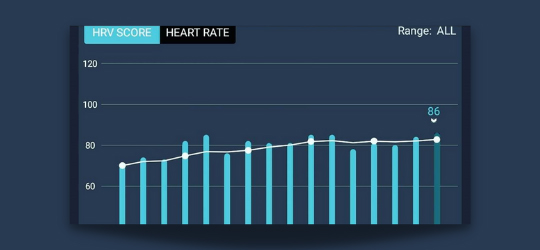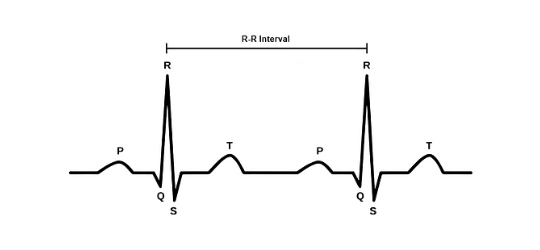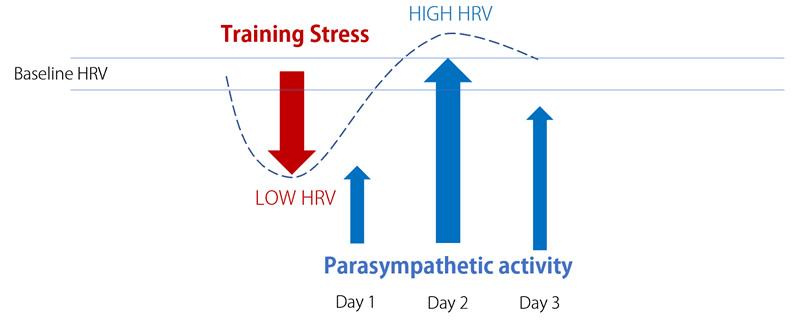Over the last few years, heart rate variability, or HRV, has become a widely used metric across a variety of fitness apps. It’s also at the heart of how Morpheus calculates your recovery score.
But what is HRV? Why does it matter?
The easiest answer is that when we measure HRV on a daily basis, it’s a noninvasive measure of how much energy your body has been spending on recovery.
Because of this, it gives us a window into the physiological cost of all the stress your body has been under recently.
When we look at HRV over the long run, the baseline HRV number is a powerful gauge of your body’s resilience against stress – both physical and mental.
People with higher average HRV tend to have greater life expectancy, lower overall disease risk, higher cardiovascular fitness, and even better self-restraint.
To understand why that is, we have to look deeper at how HRV is connected directly to recovery.

Why your heart does not work like a metronome
It’s easy to confuse heart rate with heart rate variability, but they are two very different things.
Each minute, the average person’s heart beats somewhere between 60 and 100 times.
People with higher levels or cardiovascular fitness often have resting heart rates well below that range. Of course, you can see what yours is in Morpheus.
Resting heart rate is a good gauge of general fitness, but on a daily basis, it doesn’t tell us much about recovery.
For that, instead of measuring the amount of times the heart beats in a minute, we have to look deeper.
Measuring HRV starts with accurate detection of the exact time between each heartbeat.
This is called the R-R interval.

If your heart worked like a metronome, then the R-R interval would always be the same between each heartbeat. The human body is much more complicated than that, however.
Instead, your heart rate is influenced by many different factors and it’s constantly changing. When you’re moving around and/or training, your heart rate increases as the need for oxygen to drive aerobic energy production increases.
The body’s stress response system that we discussed in earlier lessons is largely responsible for how this works.
At rest, however, the need for energy isn’t constantly changing. In this case, it’s the system that drives energy into recovery and adaptation, the parasympathetic nervous system, that plays the biggest role in controlling your heart rate.
When it fires, it causes the heart rate to slow down. At rest, it’s constantly firing, but it does so in a pulsatile pattern that has a natural variability to it.
This is much different than the constant rate of a metronome.
The result is that the stronger your parasympathetic nervous system fires, the more variable the time between heart beats becomes. This is where the variability in heart rate variability comes from.
Higher HRV means the parasympathetic nervous system is more active and driving more energy towards recovery, repair, and adaptation.
How HRV changes with stress and recovery
Given what I just said, it might seem like higher HRV is always a good thing and lower HRV is always a bad thing. Unfortunately, this is a common belief, but the truth isn’t quite that simple.
We can see why by looking at a typical pattern of HRV in response to a single period of high stress, followed by 3 days of recovery.

In this example, let’s imagine it’s an intense training session. The kind that you know you’re going to feel the next day.
Over the next two days, your body cranks up recovery by shifting more energy to rebuild and remodel all the stressed tissues, restock energy stores, etc. During this time, you’ll typically see a big rise in HRV, often well above where you started.
Exactly how high it goes depends on a variety of factors like how stressful the workout really was. How fit you are. How much you help your body out by getting enough sleep, eating well, managing mental stress, etc.
This is where your lifestyle plays a massive role in either supporting or sabotaging your recovery.
If you don’t do another hard session or put your body under another big period of stress, your HRV will eventually settle back down to your general baseline, i.e. your average HRV range.
Putting it all together
If you look through your HRV numbers in Morpheus, chances are that you’ll be able to find patterns similar to the one above.
Where things get more complicated, however, is when you train hard multiple times a week, often on back to back days. There isn’t enough time to fully recover, so you see the compounding effects of adding stress on top of stress.
When you factor in all the lifestyle pieces that help or hinder recovery, it’s easy to see why HRV being higher or lower on a single day is not always as simple as it’s often made out to be.
Fortunately, you don’t have to be a data scientist or crunch all the numbers to use HRV.
Morpheus is doing that work for you and looking at the patterns and trends when it calculates the recovery score each day.
HRV plays the biggest role in this calculation because when it’s measured accurately using Morpheus, it’s the single best overall tool we have to gauge the balance between stress and recovery.
Even more, if your goal is to look and feel your best, perform at the highest levels, and increase your healthspan, tracking your average HRV is an incredibly important and powerful way to make sure you’re on the right track.
Action step
Now that you know what to look for, take some time to look through your HRV numbers in Morpheus. See if you can find a hard training session followed by a couple of days of rest, or lower intensity, and see if you can find the pattern shown earlier.
Next, take a look at your HRV patterns across each week. See if you can spot the swings up and down based on your training schedule and lifestyle influences. Now that you know what you’re looking for in your HRV, it should become easier to see the patterns that are driving your daily recovery score.
